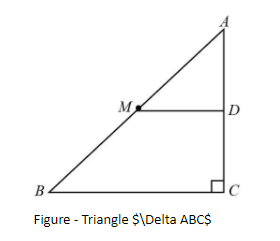
Answer
465.9k+ views
Hint: In the solution we will use the similar triangle properties. The properties may contain the Angle Angle Angle (AAA), Side Angle Side (SAS), Side Side Side (SSS) and Right angle Hypotenuse Side (RHS) properties.
Complete Step-by-step Solution
Given: The triangle $\Delta ABC$ is a right-angled triangle having angle $\angle C = 90^\circ $ and $M$ is the midpoint of $AB$.
The following is the schematic diagram of triangle $\Delta ABC$.

(i)We know that, in the right-angled triangle $\Delta ABC$, $M$ is the midpoint of line $AB$ and $MD\parallel BC$. So, according to the mid-point theorem it can be said that $D$ is the midpoint of $AC$.
Hence, it is proved that $D$ is the midpoint of $AC$.
(ii)Since, we can observe from the diagram in the right-angled triangle $\Delta ABC$, the line MD is parallel to BC that is $MD\;\parallel \;BC$ and $AC$ is transversal.
Also, we know that the interior angles on the same side of transversal AC are supplementary that is,
$\angle MDC + \angle BCD = 180^\circ $
On putting $90^\circ $ for $\angle BCD$ in the above relation we get the value of angle $MDC$.
$\begin{array}{c}
\angle MDC + 90^\circ = 180^\circ \\
\angle MDC = 90^\circ
\end{array}$
Therefore, $MB \bot \;AC$ because the angle $\angle MDC = 90^\circ $.
(iii)Now, according to Right-angle Hypotenuse Side (RHS) similar triangle properties in $\Delta AMD$ and $\Delta CMD$.
$\begin{array}{c}
AD = CD\\
\angle ADM = \angle CDM\\
DM = DM
\end{array}$
So, the triangles $\Delta AMD \cong \Delta CMD$ are congruent through SAS congruence rule.
Now, we know by the rule of CPCT,
$AM = CM$……(1)
Since, we know that $AM = \dfrac{1}{2}AB$ because it is given that M is the midpoint of AB.
$AM = \dfrac{1}{2}AB$….(2)
On equating the equations (1) and (2), we get the value as,
$CM = AM = \dfrac{1}{2}AB$
Therefore, it is proved that $CM = AM = \dfrac{1}{2}AB$.
Note: Make sure to use a rationalization method when you will see this type of questions. The tricky part is comparing the powers of the equations.
Complete Step-by-step Solution
Given: The triangle $\Delta ABC$ is a right-angled triangle having angle $\angle C = 90^\circ $ and $M$ is the midpoint of $AB$.
The following is the schematic diagram of triangle $\Delta ABC$.

(i)We know that, in the right-angled triangle $\Delta ABC$, $M$ is the midpoint of line $AB$ and $MD\parallel BC$. So, according to the mid-point theorem it can be said that $D$ is the midpoint of $AC$.
Hence, it is proved that $D$ is the midpoint of $AC$.
(ii)Since, we can observe from the diagram in the right-angled triangle $\Delta ABC$, the line MD is parallel to BC that is $MD\;\parallel \;BC$ and $AC$ is transversal.
Also, we know that the interior angles on the same side of transversal AC are supplementary that is,
$\angle MDC + \angle BCD = 180^\circ $
On putting $90^\circ $ for $\angle BCD$ in the above relation we get the value of angle $MDC$.
$\begin{array}{c}
\angle MDC + 90^\circ = 180^\circ \\
\angle MDC = 90^\circ
\end{array}$
Therefore, $MB \bot \;AC$ because the angle $\angle MDC = 90^\circ $.
(iii)Now, according to Right-angle Hypotenuse Side (RHS) similar triangle properties in $\Delta AMD$ and $\Delta CMD$.
$\begin{array}{c}
AD = CD\\
\angle ADM = \angle CDM\\
DM = DM
\end{array}$
So, the triangles $\Delta AMD \cong \Delta CMD$ are congruent through SAS congruence rule.
Now, we know by the rule of CPCT,
$AM = CM$……(1)
Since, we know that $AM = \dfrac{1}{2}AB$ because it is given that M is the midpoint of AB.
$AM = \dfrac{1}{2}AB$….(2)
On equating the equations (1) and (2), we get the value as,
$CM = AM = \dfrac{1}{2}AB$
Therefore, it is proved that $CM = AM = \dfrac{1}{2}AB$.
Note: Make sure to use a rationalization method when you will see this type of questions. The tricky part is comparing the powers of the equations.
Recently Updated Pages
10 Examples of Evaporation in Daily Life with Explanations

10 Examples of Diffusion in Everyday Life

1 g of dry green algae absorb 47 times 10 3 moles of class 11 chemistry CBSE

If the coordinates of the points A B and C be 443 23 class 10 maths JEE_Main

If the mean of the set of numbers x1x2xn is bar x then class 10 maths JEE_Main

What is the meaning of celestial class 10 social science CBSE

Trending doubts
Fill the blanks with the suitable prepositions 1 The class 9 english CBSE

Which are the Top 10 Largest Countries of the World?

How do you graph the function fx 4x class 9 maths CBSE

Who was the leader of the Bolshevik Party A Leon Trotsky class 9 social science CBSE

The Equation xxx + 2 is Satisfied when x is Equal to Class 10 Maths

Differentiate between homogeneous and heterogeneous class 12 chemistry CBSE

Difference between Prokaryotic cell and Eukaryotic class 11 biology CBSE

Which is the largest saltwater lake in India A Chilika class 8 social science CBSE

Ghatikas during the period of Satavahanas were aHospitals class 6 social science CBSE




